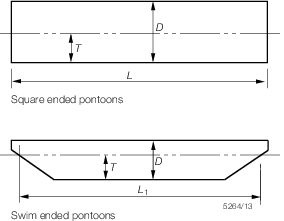
Section
1 General

1.1 Application
1.1.1 This Chapter applies to pontoons used for providing buoyant support for
ship-to-shore ramps forming part of a linkspan and which are intended for operation in
protected waters (see
Pt 1, Ch 2, 1.2 Application 1.2.5).
1.1.3 Where required, pontoons are to be fitted with adequate arrangements for
towing. In general, such arrangements are to consist of, or be equivalent to, not less
than two sets of bollards, each set being suitable for accepting a towline of suitable
breaking strength, see also
Pt 3, Ch 10 Towing and Lifting Arrangements.
1.1.6 Pontoons that are submerged to act as buoyancy chambers will be specially
considered taking into account the increase in hydrostatic pressure. Stability must also
be considered for this type of buoyant arrangement.
1.1.7 Pontoons which are designed to take the ground will be specially
considered.

1.2 Information required for approval

1.3 Symbols and definitions
1.3.1 The
Rule length, L, is to be taken as the overall length
for square ended pontoons, or for pontoons with swim ends L need
not exceed 97 per cent of the extreme length at the waterline at maximum
working draught condition, L
1, see
Figure 4.1.1 Pontoon dimensions.
1.3.2 Breadth, B, is the greatest moulded breadth, in metres.

Figure 4.1.1 Pontoon dimensions
1.3.3 Depth, D, is measured, in metres, at the middle of the length, L,
from top of bottom plating to top of the deck plating at side on the
uppermost continuous deck.
1.3.4 Draught, T, is the maximum working draught, in metres, measured from
top of bottom plating.
1.3.5 Head, h, in metres, is to be taken as:
-
for bottom longitudinals, frames, girders
and transverses: the depth D
-
for side longitudinals:
the distance of the longitudinal below the deck at side, but
not less than 0,01L + 0,7
-
for side frames and transverses:
the distance from the mid-point of span to the deck at side,
but not less than 0,01L + 0,7
-
for weather deck longitudinals and transverses:
a head of 0,01L + 0,7.

1.4 Longitudinal or transverse framing
1.4.1 Pontoons
used for this application may be longitudinally or transversely framed.
|
| Copyright 2022 Clasifications Register Group Limited, International Maritime Organization, International Labour Organization or Maritime
and Coastguard Agency. All rights reserved. Clasifications Register Group Limited, its affiliates and subsidiaries and their respective
officers, employees or agents are, individually and collectively, referred to in this clause as 'Clasifications Register'. Clasifications
Register assumes no responsibility and shall not be liable to any person for any loss, damage or expense caused by reliance
on the information or advice in this document or howsoever provided, unless that person has signed a contract with the relevant
Clasifications Register entity for the provision of this information or advice and in that case any responsibility or liability is
exclusively on the terms and conditions set out in that contract.
|
 |
|